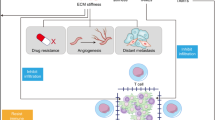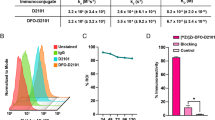Abstract
Expression of β1,6-branched N-linked oligosaccharides have a definite association with invasion and metastasis of cancer cells. However, the mechanism by which these oligosaccharides regulate these processes is not well understood. Invasive variants of B16 murine melanoma, B16F10 (parent) and B16BL6 (highly invasive variant) cell lines have been used for these studies. We demonstrate that substitution of α2,6-linked sialic acids on multiantennary structures formed as a result of β1,6-branching modulate cellular adhesion on both extracellular matrix (ECM) and basement membrane (BM) components. Removal of α2,6 sialic acids either by enzymatic desialylation or by stably down-regulating the ST6Gal-I (enzyme that catalyses the addition of α2,6-linked sialic acids on N-linked oligosaccharides) by lentiviral driven shRNA decreased the adhesion on both ECM and BM components and invasion through reconstituted BM matrigel.





Similar content being viewed by others
References
Adamczyk B, Tharmalingam T and Rudd PM 2012 Glycans as cancer biomarkers. Biochim. Biophys. Acta 1820 1347–1353
Aznavoorian S, Murphy AN, Stetler-Stevenson WG and Liotta LA 1993 Molecular aspects of tumor cell invasion and metastasis. Cancer 71 1368–1383
Chang WW, Yu CY, Lin TW, Wang PH and Tsai YC 2006 Soyasaponin I decreases the expression of alpha2,3-linked sialic acid on the cell surface and suppresses the metastatic potential of B16F10 melanoma cells. Biochem. Biophys. Res. Commun. 341 614–619
Cui H, Lin Y, Yue L, Zhao X and Liu J 2011 Differential expression of the alpha2,3-sialic acid residues in breast cancer is associated with metastatic potential. Oncol. Rep. 25 1365–1371
Cummings RD, Trowbridge IS and Kornfeld S 1982 A mouse lymphoma cell line resistant to the leukoagglutinating lectin from Phaseolus vulgaris is deficient in UDP-GlcNAc: alpha-D-mannoside beta 1,6 N-acetylglucosaminyltransferase. J. Biol. Chem. 257 13421–13427
Demetriou M, Nabi IR, Coppolino M, Dedhar S and Dennis JW 1995 Reduced contact-inhibition and substratum adhesion in epithelial cells expressing GlcNAc-transferase V. J. Cell Biol. 130 383–392
Dennis JW, Laferte S, Waghorne C, Breitman ML and Kerbel RS 1987 Beta 1-6 branching of Asn-linked oligosaccharides is directly associated with metastasis. Science 236 582–585
Fernandes B, Sagman U, Auger M, Demetrio M and Dennis JW 1991 Beta 1-6 branched oligosaccharides as a marker of tumor progression in human breast and colon neoplasia. Cancer Res. 51 718–723
Gretschel S, Haensch W, Schlag PM and Kemmner W 2003 Clinical relevance of sialyltransferases ST6GAL-I and ST3GAL-III in gastric cancer. Oncology 65 139–145
Harduin-Lepers A, Vallejo-Ruiz V, Krzewinski-Recchi MA, Samyn-Petit B, Julien S and Delannoy P 2001 The human sialyltransferase family. Biochimie 83 727–737
Jun L, et al 2012 Altered mRNA expressions of sialyltransferases in human gastric cancer tissues. Med. Oncol. 29 84–90
Kawano T, Takasaki S, Tao TW and Kobata A 1993 Altered glycosylation of beta 1 integrins associated with reduced adhesiveness to fibronectin and laminin. Int. J. Cancer 53 91–96
Krishnan V, Bane SM, Kawle PD, Naresh KN and Kalraiya RD 2005 Altered melanoma cell surface glycosylation mediates organ specific adhesion and metastasis via lectin receptors on the lung vascular endothelium. Clin. Exp. Metastasis 22 11–24
Lin S, Kemmner W, Grigull S and Schlag PM 2002 Cell surface alpha 2,6 sialylation affects adhesion of breast carcinoma cells. Exp. Cell Res. 276 101–110
Litynska A, Przybylo M, Pochec E, Kremser E, Hoja-Lukowicz D and Sulowska U 2006 Does glycosylation of melanoma cells influence their interactions with fibronectin? Biochimie 88 527–534
Lopez-Morales D, Velazquez-Marquez N, Valenzuela O, Santos-Lopez G, Reyes-Leyva J and Vallejo-Ruiz V 2009 Enhanced sialyltransferases transcription in cervical intraepithelial neoplasia. Invest. Clin. 50 45–53
Pierce M and Arango J 1986 Rous sarcoma virus-transformed baby hamster kidney cells express higher levels of asparagine-linked tri- and tetraantennary glycopeptides containing [GlcNAc-beta (1,6)Man-alpha (1,6)Man] and poly-N-acetyllactosamine sequences than baby hamster kidney cells. J. Biol. Chem. 261 10772–10777
Pili R, Chang J, Partis RA, Mueller RA, Chrest FJ and Passaniti A 1995 The alpha-glucosidase I inhibitor castanospermine alters endothelial cell glycosylation, prevents angiogenesis, and inhibits tumor growth. Cancer Res. 55 2920–2926
Pochec E, Litynska A, Bubka M, Amoresano A and Casbarra A 2006 Characterization of the oligosaccharide component of alpha3beta1 integrin from human bladder carcinoma cell line T24 and its role in adhesion and migration. Eur. J. Cell Biol. 85 47–57
Przybylo M, Martuszewska D, Pochec E, Hoja-Lukowicz D and Litynska A 2007 Identification of proteins bearing beta1–6 branched N-glycans in human melanoma cell lines from different progression stages by tandem mass spectrometry analysis. Biochim. Biophys. Acta 1770 1427–1435
Reddy BV and Kalraiya RD 2006 Sialilated beta1,6 branched N-oligosaccharides modulate adhesion, chemotaxis and motility of melanoma cells: Effect on invasion and spontaneous metastasis properties. Biochim. Biophys. Acta 1760 1393–1402
Seales EC, Jurado GA, Brunson BA, Wakefield JK, Frost AR and Bellis SL 2005 Hypersialylation of beta1 integrins, observed in colon adenocarcinoma, may contribute to cancer progression by up-regulating cell motility. Cancer Res. 65 4645–4652
Spano D, Heck C, De Antonellis P, Christofori G and Zollo M 2012 Molecular networks that regulate cancer metastasis. Semin. Cancer Biol. 22 234–249
Srinivasan N, Bane SM, Ahire SD, Ingle AD and Kalraiya RD 2009 Poly N-acetyllactosamine substitutions on N- and not O-oligosaccharides or Thomsen-Friedenreich antigen facilitate lung specific metastasis of melanoma cells via galectin-3. Glycoconj. J. 26 445–456
Suzuki O, Nozawa Y, Kawaguchi T and Abe M 2003 Alpha-2,6-sialylation of L-PHA reactive oligosaccharides and expression of N-acetylglucosaminyltransferase V in human diffuse large B cell lymphoma. Oncol. Rep. 10 1759–1764
Takano R, Nose M, Nishihira T and Kyogoku M 1990 Increase of beta 1–6-branched oligosaccharides in human esophageal carcinomas invasive against surrounding tissue in vivo and in vitro. Am. J. Pathol. 137 1007–1011
Tomiie M, Isaka S, Miyoshi E, Taniguchi N, Kimura T, Ogita K, Tsutsui T and Shimoya K 2005 Elevated expression of N-acetylglucosaminyltransferase V in first trimester human placenta. Biochem. Biophys. Res. Commun. 330 999–1004
Towbin H, Staehelin T and Gordon J 1979 Electrophoretic transfer of proteins from polyacrylamide gels to nitrocellulose sheets: procedure and some applications. Proc. Natl. Acad. Sci. USA 76 4350–4354
Wang PH, Lee WL, Juang CM, Yang YH, Lo WH, Lai CR, Hsieh SL and Yuan CC 2005 Altered mRNA expressions of sialyltransferases in ovarian cancers. Gynecol. Oncol. 99 631–639
Yamamoto H, Hurh J, Sweeley C, Leestma J, Mkrdichian E, Cerullo L, Nishikawa A and Ihara Y 2000 Beta1,6-N-acetylglucosamine-bearing N-glycans in human gliomas: implications for a role in regulating invasivity. Cancer Res. 60 134–142
Yoshimura M, Nishikawa A, Ihara Y, Taniguchi S and Taniguchi N 1995 Suppression of lung metastasis of B16 mouse melanoma by N-acetylglucosaminyltransferase III gene transfection. Proc. Natl. Acad. Sci. USA 92 8754–8758
Zhuo Y and Bellis SL 2011 Emerging role of alpha2,6-sialic acid as a negative regulator of galectin binding and function. J. Biol. Chem. 286 5935–5941
Acknowledgements
We acknowledge Prof IJ Fidler for kindly providing the murine B16 melanoma cell lines and the support received from Mr Sanjay Bane for his help in some of the key experiments. We thank Ms Hemal Somaiya for cloning ST6Gal-I shRNA in pTRIPz vector and Mrs Rekha Gaur and Ms Shamal Vetale for acquisition of Flow cytometric data, and Mr Chavan and Mr Pawar for their technical support. We thank Council of Scientific and Industrial Research (CSIR), India, for their financial support towards the project and Department of Biotechnology (DBT), India, for the Junior and Senior Research Fellowships to AR.
Author information
Authors and Affiliations
Corresponding author
Additional information
Corresponding editor: SUDHA BHATTACHARYA
Ranjan A and Kalraiya RD 2013 α2,6 Sialylation associated with increased β1,6-branched N-oligosaccharides influences cellular adhesion and invasion. J. Biosci. 38 1–10] DOI 10.1007/s12038-013-9382-z
Rights and permissions
About this article
Cite this article
Ranjan, A., Kalraiya, R.D. α2,6 Sialylation associated with increased β1,6-branched N-oligosaccharides influences cellular adhesion and invasion. J Biosci 38, 867–876 (2013). https://doi.org/10.1007/s12038-013-9382-z
Received:
Accepted:
Published:
Issue Date:
DOI: https://doi.org/10.1007/s12038-013-9382-z




